
In recognition of the need for gender equality and empowering women and girls in science, the United Nations General Assembly proclaimed 11th February as the International Day of Women and Girls in Science in 2015. On this special occasion, let us celebrate the achievements and contributions of some of the remarkable women scientists in our faculty!
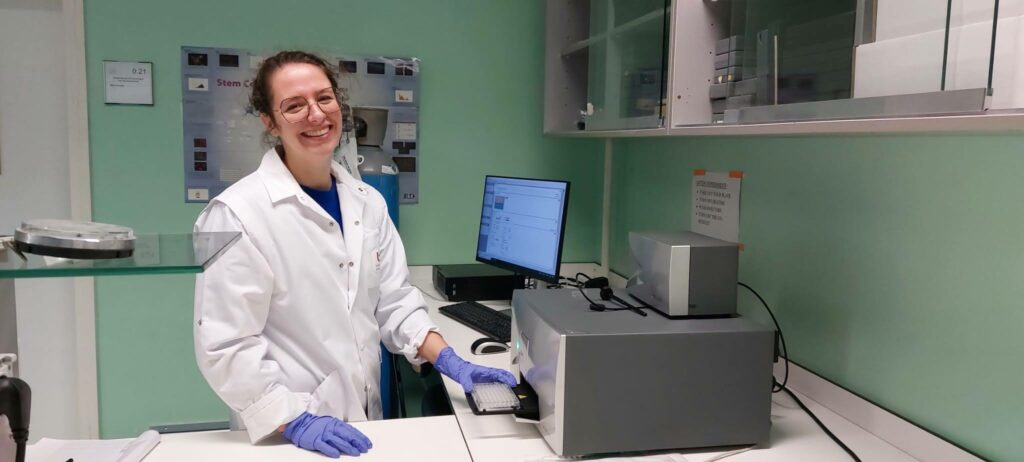
Laura Buyssens
Hello! I’m Laura Buyssens, a final-year PhD student and teaching assistant working under the guidance of Professors Steven Van Cruchten and Chris Van Ginneken in the Comparative Perinatal Development Group. Over the past six years, my PhD research has focused on exploring the development of liver enzymes, specifically Cytochrome P450 enzymes, in piglets. I’m investigating if these piglets can serve as a model for human preterm newborns in the development of new medications. In addition to my research, I’m also involved in running practical classes for veterinary anatomy and embryology courses.

Melissa Van Praet & Céline Civati
Hi, I’m Melissa Van Praet and I’m a PhD student in the Physiopharmacology Group with Professors Lynn Roth and Wim Martinet. My research focus is on the critical issue of cardiovascular diseases, which are still the leading cause of death worldwide. My work involves investigating the role of elastin-derived peptides in arterial stiffness and atherosclerosis.
I’m Céline Civati, also PhD student in the Physiopharmacology Group, and I work with Professors Vincent Segers and Gilles De Keulenaer. My research is centered on exploring the connection between heart failure and cancer, and specifically, the impact of heart failure treatments on cancer growth.
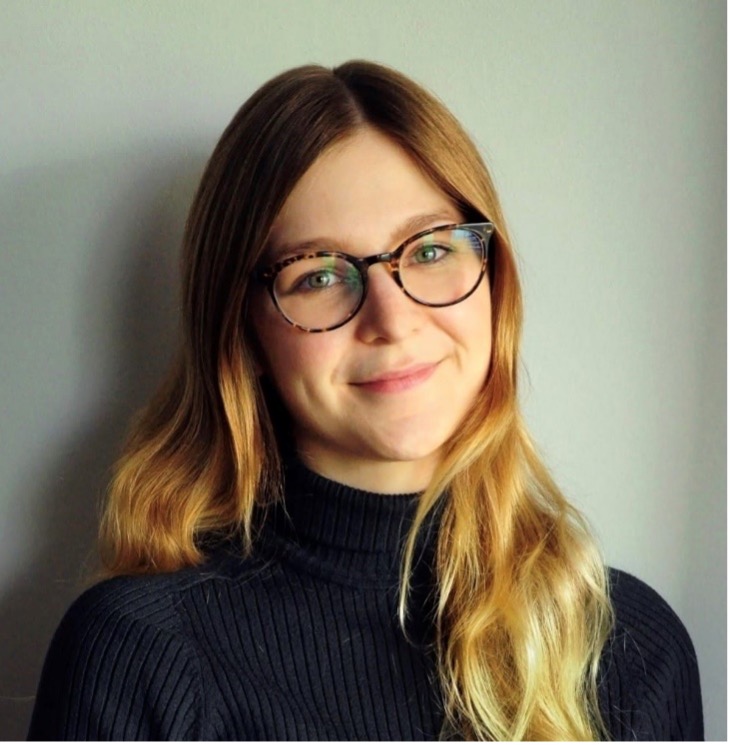
Laura Dirkx
I’m Laura Dirkx and I’m a PhD student in the Laboratory of Microbiology, Parasitology and Hygiene (LMPH), with Professors Guy Caljon and Louis Maes. The focus of my PhD research is on treatment failure during infection with a deadly parasite called Leishmania. This parasite causes visceral leishmaniasis, a disease that infects organs such as the liver, spleen and bone marrow. Current treatments are toxic and there is an increasing risk of treatment failure or relapse. This means for example that one year after treatment you can get sick again from the same parasite. During my PhD research, we found a specific stem cell in the bone marrow that serves as a hiding place or niche, sheltering parasites from immune responses or drug treatment. Here, parasites first expand very fast to the transform into a sleeping state. Both the stem cell niche and entry of parasites into a sleeping state are part of the reason why Leishmania can survive treatment and cause relapse. Now, we are designing a combination therapy, to make sure that when you are treated against leishmaniasis that all the parasites are cleared out from your body.
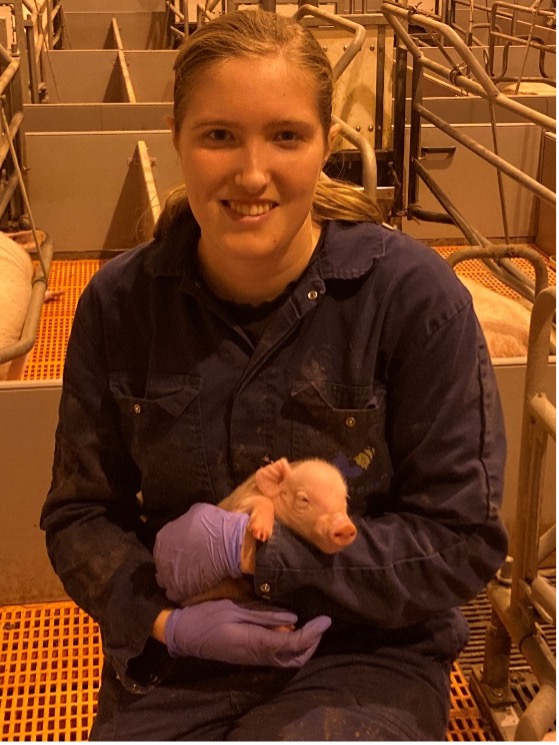
Marlotte Loyens
My name is Marlotte Loyens, and I’m in the first year of my PhD at the Comparative Perinatal Development Group, under the supervision of Professors Chris Van Ginneken and Steven Van Cruchten. My PhD research focuses on sex-related differences in intrauterine growth restriction (IUGR) piglets. Newborns with IUGR are characterized by impaired growth and low birth weight because of insufficient oxygen and nutrients during their development. They have different morbidity compared to the newborns with a normal phenotype. Pigs are often used as an animal model to study the mechanisms of IUGR, as IUGR in pigs is a natural phenomenon, and the IUGR phenotype is consistent with humans. I am currently doing an observational study to record the performance and health of neonatal normal and IUGR piglets. This will be combined with a detailed investigation of the morphology and molecular mechanisms of the umbilical cord and the vascularization of various organs in male and female IUGR piglets. The results of this project will open new avenues for improving diagnostics and sex-based personal medicine. Moreover, the detailed description of the IUGR phenotype in neonatal and juvenile piglets will contribute to a one-health approach to improve both human and pig health.
Besides my research project, I assist in several practical classes in Veterinary Anatomy and Laboratory Animal Science. Here, I enthusiastically guide students during their training, where I try to share my love for animals and science.
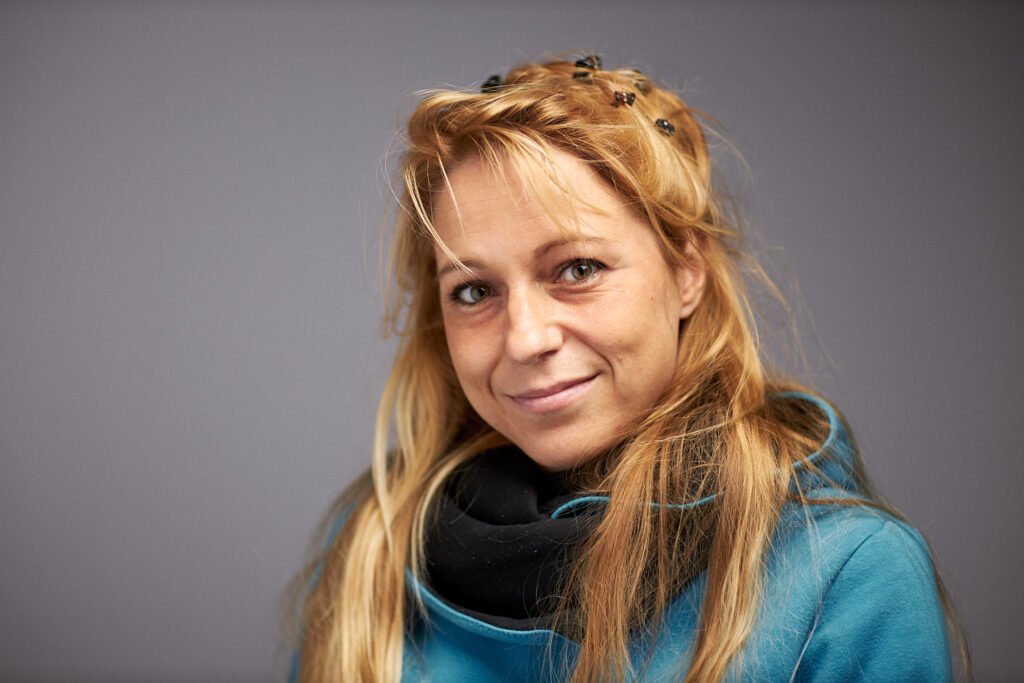
Ruth Appeltant
I am a Tenure Track Research Professor in the Department of Veterinary Sciences. My research is focused on using stem cell technology to improve fertility preservation in humans and endangered species.
Primary ovarian insufficiency, in which ovarian reserves are depleted and/or the ovary cease to function normally, affects approximately 0.1% of women under 30 and 1% of women under 40 years old. Several options are clinically available to women who are willing to preserve their fertility, such as embryo and egg freezing. Those techniques each have their own strengths and weaknesses. The drawbacks have led scientists and clinicians to search for alternative and more robust methods. Moreover in the context of biodiversity, the earth is currently facing global-wide extinction levels higher than any previously experienced, termed “the sixth extinction.” Assisted reproductive technology have played a growing role in maintaining genetic diversity in mammalian species. The bottleneck of this approach is often the lack of eggs in the ovaries of the few remaining individuals of a species. The most promising approach to solve the lack of own eggs in human and endangered species is based on stem cells and called ‘in vitro gametogenesis’. My research group, within the Gamete Research Centre, focusses on isolating stem cells from the ovary to verify their existence and test their potential to be differentiated into eggs. Going even a step further, there is the future perspective of using normal and easily available body cells such as cells from skin biopsies to transform those into stem cells and subsequently turn those into eggs. As pig models are recognized worldwide as excellent models for human diseases and in vitro embryo production research, we will use the pig as a model to develop the stem cell techniques.
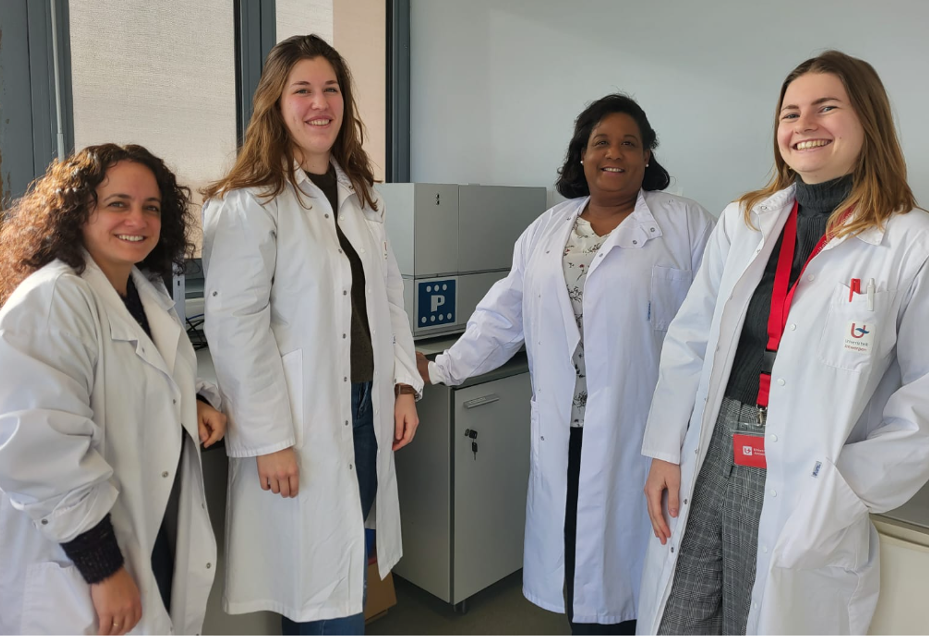
Women in the Protein Chemistry, Proteomics and Epigenetic Signalling (PPES) lab, headed by Prof. Wim Vanden Berghe.
Dr. Claudina Perez Novo (3rd from left)
All my years in biomedical research have been driven by my passion to understand the molecular signaling mechanisms leading to oncological, pro-inflammatory and neurodegenerative diseases. In the last seven years at the University of Antwerp, I have worked as the Project Manager for the Kino2Omics platform, which provides services to academic, clinical research groups and biotech companies! This platform enables the deciphering of the crucial roles that phosphoproteins have in different health and disease models by profiling the protein kinase activity. I have gained unique expertise in applying this technology with an Omics-data integration approach to a broad spectrum of fundamental, translational, diagnostic, and clinical research. My final goal? To narrow the bridge between disease and drug discovery strategies.
Dr. Laura García Pupo (1st from left)
After ten years of experience in rational drug design and development for the treatment of acute and chronic neurological diseases, the University of Antwerp invited me to become an MSCA Seal of Excellence postdoctoral fellow. During my fellowship, I combine forces with both PPES and the Laboratory of Experimental Hematology to generate mouse brain organoids and to study their broad molecular signaling in response to different stimuli. Brain or cerebral organoids are artificial 3D assemblies of different nerve cells derived from pluripotent stem cells. They are regarded as a promising innovative platform to study the pathophysiology of neurological diseases and to evaluate novel drug candidates. The aim of my project is to decipher if brain organoids can functionally resemble the molecular mechanisms in animal models or patients.
Claudia Theys (2nd from left)
During my PhD at PPES I focus on the epigenetic role of the main regulators of the lipid metabolism in non-alcoholic fatty liver disease (NAFLD) in vitro and in mice. More specifically, I focus on the nuclear receptor PPARa and mitochondria to find new therapeutic targets for future drug discovery. NAFLD is a growing epidemic, mirroring the increase in obesity and worldwide the most common cause of chronic liver disease. As there is currently no approved treatment, research is focused on finding new therapeutic targets. In my project, I aspire to elucidate the epigenetic role of PPARa and mitochondrial DNA methylation in NAFLD through global and site-specific DNA‑methylation and combine this information with RNA-Sequencing.
Amber Driesen (4th from left)
As an FWO Fundamental Fellow, my research focus is on the potential of iron epigenetics in treating multiple myeloma cancer. I’m exploring ferroptosis, a form of iron-dependent cell death, as a promising alternative treatment option, with a particular emphasis on the histone epigenetic regulation. With my background in biochemistry, I’m able to delve into the mechanisms of iron-regulated epigenetics at both the protein and cellular levels. My ultimate goal is to make a fundamental contribution to our understanding of ferroptosis and potentially pave the way for new (epigenetic) treatment options for multiple myeloma patients.
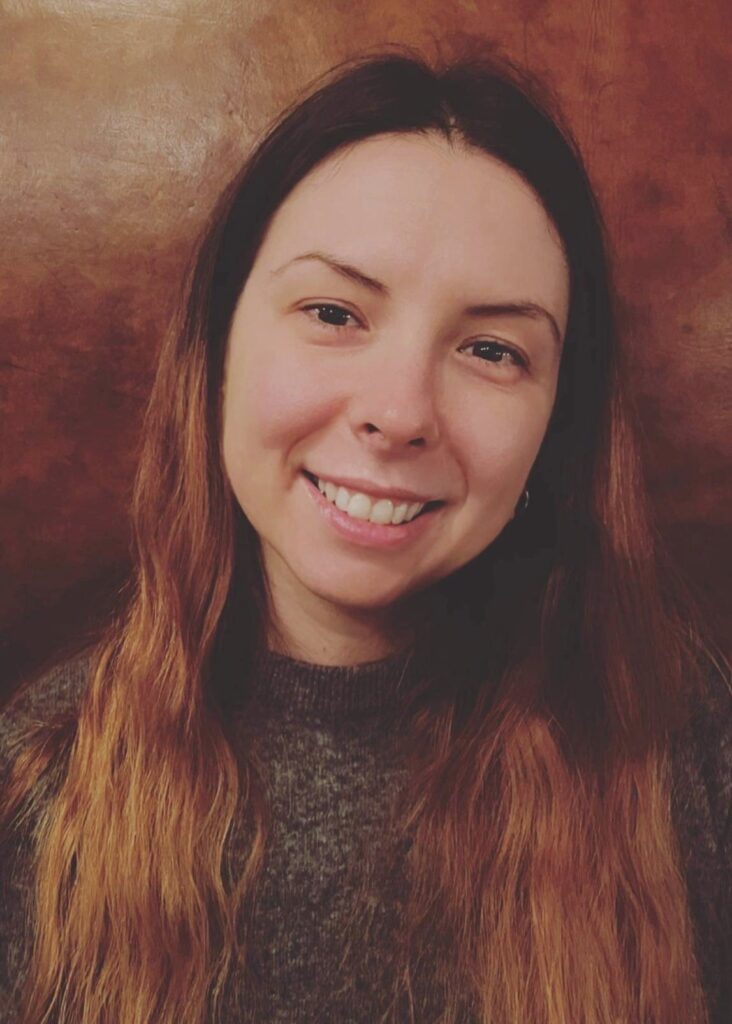
Tamara Vasilkovska
Hello, I’m Tamara Vasilkovska, a PhD student in the Bio-Imaging Lab, under the guidance of Professors Marleen Verhoye and Annemie Van der Linden. Have you ever pondered how your brain processes the world around you? I’m passionate about exploring this question as a researcher in the field of system neuroscience. My goal is to understand the brain connectivity that creates specific brain states, which can reveal how our brain functions when at rest and how these connections are impaired in neurodegeneration.
In my PhD work, I’m studying the impact of Huntington’s disease (HD), a common and incurable hereditary neurodegenerative disease, on brain states and networks. I utilize magnetic resonance imaging (MRI) to assess functional brain connectivity, which enables us to identify changes in the brain and evaluate potential novel therapeutic strategies with the goal of finding a cure for HD.
Another area of focus in my research is the role of the central nervous system in clearing toxic waste, specifically mutant huntingtin protein (mHTT) in HD. By investigating how the HD brain tries to clear out this toxic protein, we can identify new routes for treatment and enhance the removal of mHTT from the brain.
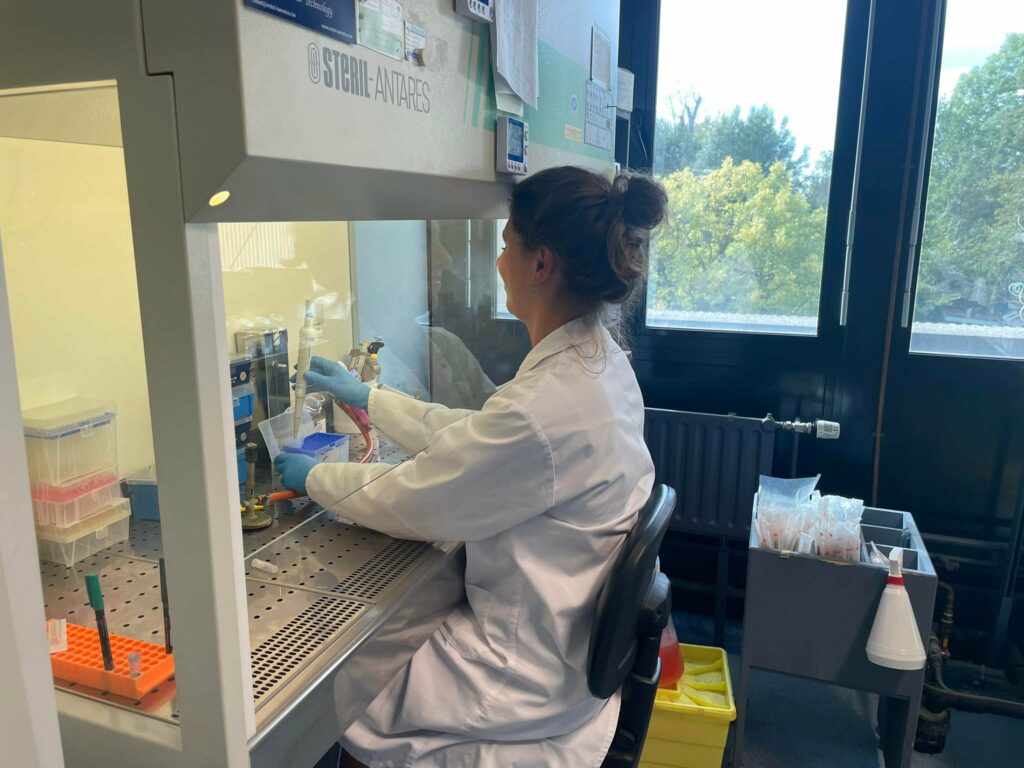
Julie Cools
I am a PhD student in the Laboratory of Physiopharmacology, under supervision of Professors Vincent Segers and Gilles De Keulenaer. I am researching the potential of ERBB4 small-molecule agonists as a promising therapy for chronic heart failure. I am working on the development of ERBB4 small-molecule agonists as a promising therapy for chronic heart failure. It has shown that the neuregulin-1 (NRG1)/ERBB4 pathway is involved in cardiac embryonic development but it also becomes reactivated during cardiac overload or injury as a compensatory factor.
While NRG1 is already being tested as a treatment for heart failure, its administration through intravenous injections limits its efficacy and applicability. Additionally, NRG1 is a non-selective agonist of the ERBB3 receptor, which can increase the risk of carcinogenic effects. Therefore, my goal is to develop a selective ERBB4 small-molecule agonist that can provide cardioprotective benefits for chronic heart failure patients. I am eager to use my expertise in the field to optimize this therapy and help make a positive impact on the lives of those affected by this debilitating condition.
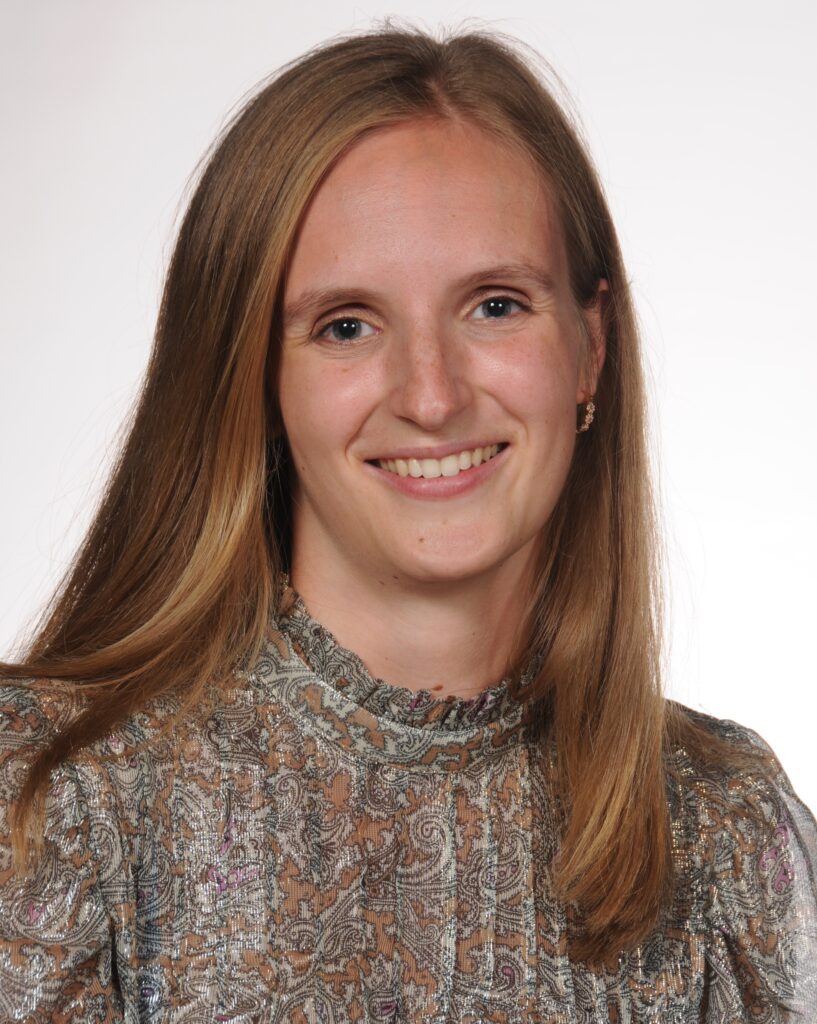
Rani Robeyns
Hi there! I’m Rani Robeyns and I’m on a mission to unravel the mysteries of autophagy – you know, that fancy process that helps keep our cells healthy and happy. I started my PhD at the Toxicological Centre in 2021, under the supervision of Professors Alexander van Nuijs and Sigrid Stroobants. I am using an untargeted metabolomics LC-HRMS approach to better understand the molecular mechanisms underlying autophagy induction. This complex process has considerable potential as a therapeutic approach in cardiovascular disease and different types of neurodegenerative disease. I’m a firm believer that science can make a real difference in people’s lives, and I’m excited to be part of the team that is making it happen!

Siel Van den Bogaert
I’m Siel Van den Bogaert a PhD student and teaching assistant in the Laboratory of Physiopharmacology, under supervision of Professors Gilles De Keulenaer and Vincent Segers. Millions of people suffer from myocardial infarctions, resulting in the loss of billions of cardiomyocytes. This may lead to the development of heart failure. The proliferation capacity of cardiomyocytes in adults is limited, resulting in a limited self-healing capacity of the human heart. The loss of cardiomyocytes and the resulting loss of function are irreversible. Effective cardiac regeneration strategies could prevent this loss of cardiomyocytes and thus heart failure in the affected patients. Neonatal mice in the first week of life can regenerate their hearts after injury by myocardial infarction, and this process is mediated by proliferation of preexisting cardiomyocytes. I am investigating other factors that could target these cardiac regenerative properties. The aim of my research is to reveal the science behind a myocardial infarction and to improve the therapy for these patients.
